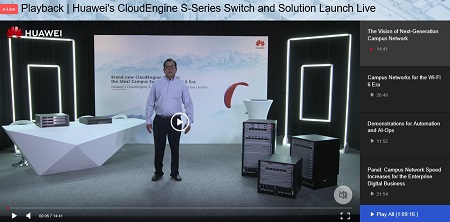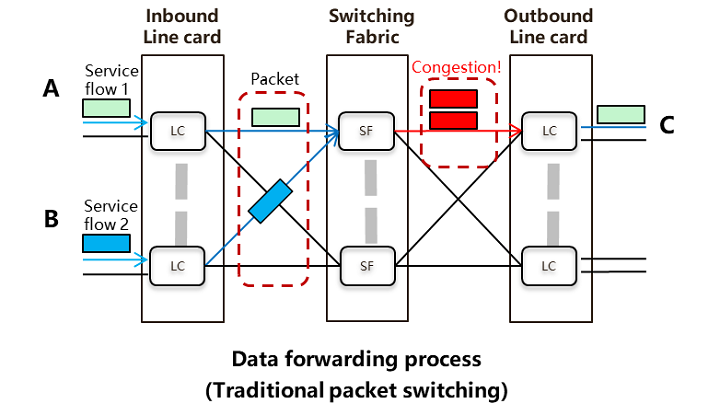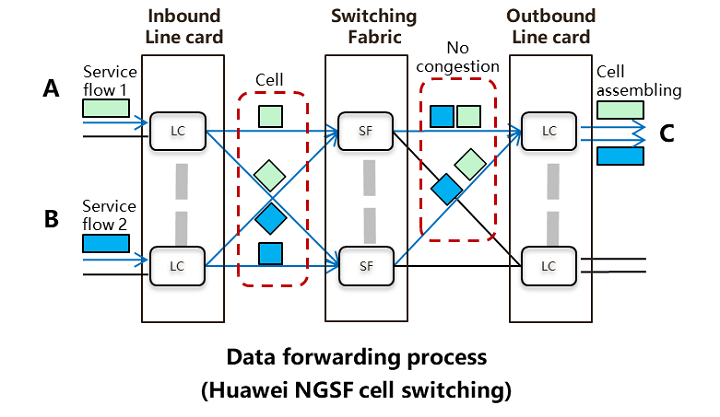Produkte, Lösungen und Services für Unternehmen
Smartphones, PCs & Tablets, Wearables, mobiles Breitband und mehr
Über Huawei, Nachrichten, Veranstaltungen, Brancheneinblicke und mehr
In 2013, Huawei made a big breakthrough in campus networking by launching a series of innovative solutions and products, including the groundbreaking Agile Campus Network Solution and the industry's first agile switch —S12700. In this solution, Agile Controller and S12700 collaborate to build a brand-new campus network in line with the Software-Defined Networking (SDN) philosophy. Agile Controller works as the brain of the entire campus network; it centrally manages network-wide resources and implements refined control and automated provisioning of user policies. S12700, the data exchange and policy enforcement center, leads the industry by leveraging Ethernet Network Processor (ENP) chips to usher in wired and wireless convergence, achieving converged deployment and management of both wired and wireless networks. The emergence of the campus network represented by the SDN architecture marks a shift from "data forwarding-centric" to "policy control-centric" networks.

In recent years, more and more terminals of mobile office, production, and operation have chosen wireless as the preferred access mode. In this way, the access capability of wireless networks is higher than that of wired networks, and the emergence of Wi-Fi 6 makes it possible. Wi-Fi 6 outperforms Wi-Fi 5 by introducing many latest technologies such as Multiple-User Multiple Input, Multiple Output (MU-MIMO) (in both upstream and downstream directions), Orthogonal Frequency Division Multiple Access (OFDMA), and 1024-state Quadrature Amplitude Modulation (1024-QAM). By delivering four-fold increases in both user access capacity and service bandwidth, Wi-Fi 6 allows a large number of users to connect concurrently in high-density Wi-Fi scenarios and ensures good user experience for applications that require high bandwidth and low latency. The emergence of new technology has greatly improved Wi-Fi performance, ensuring that Wi-Fi will be the preferred access mode for digital production and services in the future.
Meanwhile, cloud technologies are transforming the way users experience applications on campus networks at an accelerated pace. In the next five years, the number of cloud applications will grow five times faster than that of non-cloud applications. More applications, spanning from offices to production lines, will shift from on-premises deployment to cloud deployment, greatly disrupting the data traffic model of campus networks. The bandwidth requirement of a single user will increase from about 10Mbps to 50Mbps above. At the same time, each application needs to provide 10 ms ~ 30 ms deterministic latency assurance, which is a strong challenge for the current network.
You must rethink how to build a brand-new campus network that ensures deterministic service experience. This new network should allow fast access and traffic forwarding for user terminals, provide efficient Operations and Maintenance (O&M) tools to IT personnel for real-time user experience assurance, and deliver an open architecture for future network evolution.
On June 28, 2019, We launched the next-generation core switch CloudEngine S12700E and CloudEngine S-series fixed switches, which are tailored for future campus networks. These additions provide the massive terminal connections and ultrafast service access needed for the Wi-Fi 6 era, it will work as the cornerstone for building a service experience-centric campus network of the future.

CloudEngine S12700E is available in three models — offering 4, 8, or 12 service slots — and some service cards of it are compatible with the current S12700 series switches. You can make a proper choice based on the current or future requirements of the campus network to be built. CloudEngine S12700E inherits the distributed hardware architecture to ensure high reliability and smooth evolution in the future. Meanwhile, based on next-generation backplane and Switch Fabric Units (SFUs), CloudEngine S12700E provides a high density of up to 288 x 100GE ports, and delivers up to 4.8 Tbit/s single-slot bandwidth and 57.6 Tbit/s switching capacity, six times that of the industry average, as verified by Tolly (Download Tolly Report). In addition, CloudEngine S12700E meets customers' network evolution and service needs over the next 5 to 10 years by further improving single-slot bandwidth and system switching capacity by simply upgrading SFUs.
Compared with the S12700, CloudEngine S12700E stands out with hardware performance improvement and, more importantly, a brand-new Next Generation Switch Fabric (NGSF) cell switching architecture and Solar chips. These pave the way for building a campus core with ultrafast traffic forwarding that can easily evolve.
CloudEngine S12700E is designed with an innovative NGSF switching architecture and is the first of its kind to introduce the cell switching and dynamic load balancing algorithms, achieving non-blocking, lossless ultrafast traffic forwarding at the campus core. CloudEngine S12700E resolves the congestion and packet loss problems caused by packet switching and static hashing algorithms when traditional core switches are heavily loaded.
For traditional campus switches, packets are switched according to the following process. First, upon receiving service flows, an inbound line card randomly selects a switching fabric to which it then sends data packets based on a hashing algorithm. Then, the switching fabric forwards the data packets to an outbound line card, which then delivers these packets to the target end user.
This conventional approach is workable in a network with a light load. However, with the growth of user concurrency and single-user bandwidth, two significant problems emerge. First, the switching fabric is randomly selected based on the hashing algorithm, which can easily cause unbalanced loads among switch fabrics and therefore affect the overall performance. Second, when multiple inbound line cards select the same switching fabric, this switching fabric becomes congested due to being overloaded with concurrent traffic, resulting in the loss of data packets. As illustrated in the following figure, the switching fabric is congested when users A and B send service flows simultaneously to user C.

Huawei NGSF architecture innovatively processes service flows as follows. First, upon receiving the service flows sent by users A and B, an inbound line card slices data packets into cells, selects a switching fabric dynamically based on loads, and sends the cells to the optimal switching fabric. Then, the switching fabric forwards the cells to an outbound line card, which then assembles cells into data packets and sends them to the target end user. This innovative cell switching mechanism achieves dynamic load balancing of the switching fabrics, and maximizes the switching performance. In addition, multipath transmission of cells prevents network congestion and service loss caused by overload of a single switching fabric, thereby providing better Quality of Service (QoS) assurance.

Huawei CloudEngine S-series switches are equipped with Huawei's next-generation programmable Solar S-series chips. These latest chips outperform the previous-generation ENP chips by significantly improving data exchange performance, data analysis and processing, and application identification assurance. Built on Huawei's Versatile Routing Platform (VRP), CloudEngine S-series switches provide numerous advanced features, including wired and wireless convergence (integrated WLAN AC), free mobility, horizontal virtualization, vertical virtualization (Super Virtual Fabric, or SVF), network virtualization (VXLAN), deployment automation (NETCONF/YANG), intelligent O&M (Telemetry), and advanced security protection (NetStream and Encrypted Communications Analytics, or ECA). With a fully programmable architecture, CloudEngine S-series switches accelerate the provisioning of new services and features through programming without the need for hardware upgrades, fully protecting customer investments.
Huawei is the first vendor in the industry to propose and launch wired and wireless convergence features and solutions that, to date, have been widely used and proven in medium- and large-sized networks in world-renowned universities, governments, enterprises, stadiums, and primary/secondary education institutions. To embrace the all-wireless access trend in the campus network domain, New CloudEngine S12700E integrates the WLAN AC function based on Solar S-series programmable chips to manage up to 10,000 APs and allow concurrent access of 50,000 users. In contrast with the traditionally separated management of wired and wireless networks, CloudEngine S12700E achieves true wired and wireless convergence, including centralized service forwarding, unified device management, and converged policy control. This convergence saves a considerable amount of network construction and operating costs compared with a standalone WLAN AC or WLAN AC cards (used with modular switches). Only one switch can manage devices, users, and policies in a unified manner.

The Wi-Fi 6 era is fast approaching. In preparation, Huawei has launched the industry-leading CloudCampus Solution that builds on Agile Controller (a one-stop management center), CampusInsight (an intelligent O&M platform based on AI), the security analysis platform Cybersecurity Intelligence System (CIS), New CloudEngine S-series switches and AirEngine series WLAN products. This future-proof solution can help customers build an ultrafast, intelligent, and open campus network centered on service experience.
As a leading global campus network solution provider, Huawei is dedicated to future-proof R&D and design, and continuously innovates products and solutions best suited for customers' growing service needs. Huawei constantly provides the leading and most suitable network solutions for global customers and helps accelerate digital transformation across industries.
Together with you, building a future-proof campus network.